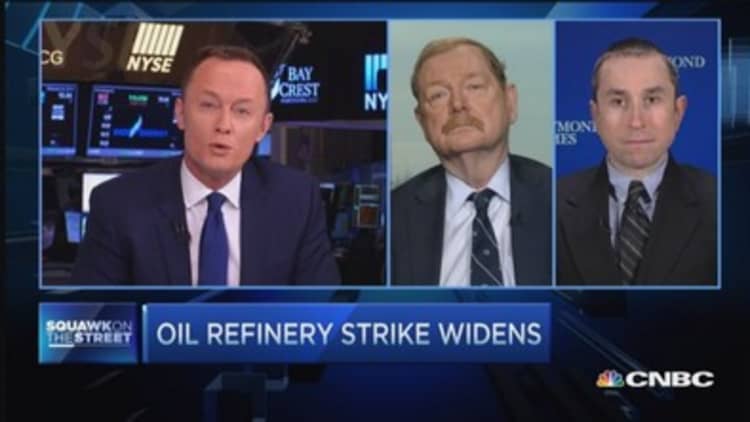


West Texas Intermediate crude closed lower Monday after it spiked on reports that OPEC could hold an emergency meeting to deal with the oil price slide.
The oil minister of OPEC member Nigeria said the group had discussed the prospect of holding a meeting, the Financial Times reported.
U.S. WTI crude April futures settled down $1.36, at $49.45 a barrel, having briefly touched a session high of $50.99. Benchmark Brent crude was down $1.30 at $59.90, after spiking as high as $60.67.
Read More
Oil prices more than halved between June and January. The decline accelerated in November when Saudi Arabia and Gulf allies used their influence within OPEC to keep production rates stable, rather than cutting output to prop up prices.
Since Brent reached a low of $45.19 on Jan. 13, prices have picked up. Brent futures jumped to $63 a barrel last week as traders closed longstanding short positions in reaction to a falling U.S. rig count.

Oil prices were down much of Monday on worries of oversupply and a strong dollar, but bets the market had hit bottom after a seven-month selloff limited the downside, traders said.
The weekly decline in the number of U.S. rigs drilling for oil slowed last week as crude prices rebounded from January lows, raising worries about oil inventories that were already at record highs.
The largest U.S. refinery strike in 35 years, involving workers at 12 refineries that account for one-fifth of the national production capacity, has also been a negative for crude.
U.S. East Coast refineries have also been hit by cold weather, sending up heating oil futures on fears of tight supplies.
Read More
But a smaller-than-expected build in the Cushing, Oklahoma delivery point for U.S. crude reported on Monday by oil services firm Genscape helped prices pare some initial losses. Genscape reported a build of 2.2 million barrels for Feb. 13 to 20, versus trade expectations for 4 million barrels or more, according to a market source who saw the data.
The market has also been seeing quick "buying on dips," evidence that bulls were in more control than a few months ago, traders said. After percentage losses of between 9 and 18 percent each month from October to December, prices consolidated in January and in February rebounded as much as 11 percent month-to-date.
"There is the notion that a bottom has been set at $55 for Brent and $45 for WTI, and there are enough buyers out there each time the market tests those levels," said John Kilduff, partner at New York energy hedge fund Again Capital.
Wall Street banks Goldman Sachs and Morgan Stanley both cautioned about rising supplies and their impact on prices.
"Despite optimism about the large drop in the U.S. rig count in recent weeks, the pace of decline has been decelerating," Morgan Stanley said. "A further slowing would only reinforce concerns that a large production decline could take longer."
Read MoreHow Saudi Arabia can withstand the shale oil boom
U.S. oil production growth is expected to reach 440,000 barrels per day by the fourth quarter of 2015 compared with a year before, based on the current rig count, Goldman said in a note.

